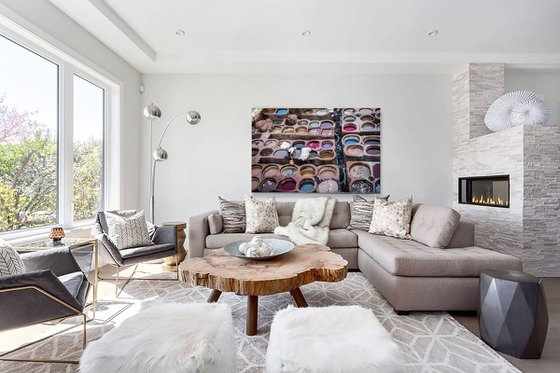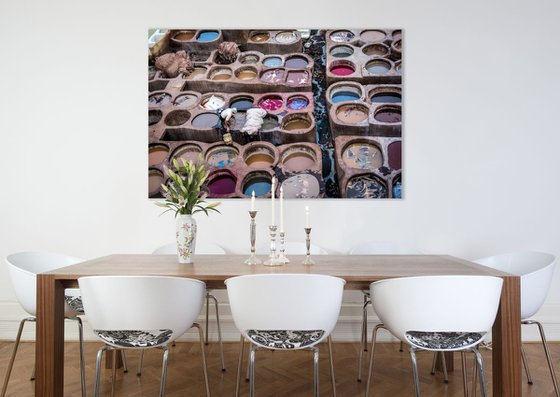- By medium
- By subject
- By budget
- Sales
- Gift cards
- Discover all art
- Artists
- Editors’ picks
- Ideas
Artwork description:
The city of Fes - Morocco's third largest city – was founded in the 8th century and it has a distinct traditional character. Located behind a high wall, in the car-free alleys of the old town or medina where hundreds of merchants and craftsmen sell a range of products are several tanneries which are almost a thousand years old.
Fes’ tanneries are composed of numerous stone vessels filled with a vast range of dyes and various liquids spread out like a tray of watercolors. Dozens of men, many standing waist deep in dyes, work under the hot sun tending to the hides that remain soaked in the vessels. The tanneries process the hides of cows, sheep, goats and camels, turning them into high quality leather products such as bags, coats, shoes, and slippers. This is all achieved manually, without the need for modern machinery, and the process has barely changed since medieval times.
Hides are first soaked in a mixture of cow urine, quicklime, water, and salt. This caustic mixture helps to break down the tough leather, loosen excess fat, flesh, and hair that remain on them. The hides are soaked for two to three days after which tanners scrap away excess hair fibers and fat in order to prepare the hides for dyeing. The hides are then soaked in a mixture of water and pigeon poop. Pigeon poop contains ammonia that acts as softening agents that allow the hides to become malleable so they can absorb the dye. The tanner uses his bare feet to knead the hides for up to three hours to achieve the desired softness.
The hides are then placed in dying pits containing natural vegetable dyes, such as poppy flower (red), indigo (blue), henna (orange), cedar wood (brown), mint (green), and saffron (yellow). Other materials used for dyeing include pomegranate powder, which is rubbed on the hides to turn them yellow, and olive oil, which will make them shiny.
Once the leather is dyed it is taken out to dry under the sun. The finished leather is then sold to other craftsmen who make the famous Moroccan slippers, as well as wallets, handbags, furniture and other leather accessories.
Only 4 Left! Limited Edition 2 of Only 5.
Signed Certificate of Authenticity with Edition Number
- Océ LightJet print on KODAK Metallic (235 g/m²) paper for a striking look. Its glossy finish and metallic appearance create images with exceptional visual interest and depth.
- Archival Quality - The colours remain brilliant – even after 100 years
- With a 2 cm white border for easy framing
- The gallery standard print comes rolled inside a hard tube protected with bubble wrap and acid free paper and shipped inside a cardboard box- Please allow 30 days for delivery depending on location
Framed or Aluminium Dibond mounting is also available,
Contact the Artist for details
Materials used:
KODAK Metallic (235 g/m²) paper
Tags:
#abstract #red #traditional #man #colourful #dawn #painting #blue #pattern #travel #surreal #photography #watercolour #fine art #color #colorful #men #people #colour #geometry #dusk #watercolors #metallic #industrial #watercolor #fabric #prints #work #documentary #inspirational #morocco #aquarelle #working #photojournalism #labourWatercolour (2016) Photograph
by Serge Horta
6 Artist Reviews
£1,224.16
- Photograph on Paper
- From a limited edition of 5
- Size: 120 x 80 x 0.5cm (unframed) / 124 x 84cm (actual image size)
- Signed and numbered certificate of authenticity
- Style: Photorealistic
- Subject: Abstract and non-figurative
Loading
Artwork description
The city of Fes - Morocco's third largest city – was founded in the 8th century and it has a distinct traditional character. Located behind a high wall, in the car-free alleys of the old town or medina where hundreds of merchants and craftsmen sell a range of products are several tanneries which are almost a thousand years old.
Fes’ tanneries are composed of numerous stone vessels filled with a vast range of dyes and various liquids spread out like a tray of watercolors. Dozens of men, many standing waist deep in dyes, work under the hot sun tending to the hides that remain soaked in the vessels. The tanneries process the hides of cows, sheep, goats and camels, turning them into high quality leather products such as bags, coats, shoes, and slippers. This is all achieved manually, without the need for modern machinery, and the process has barely changed since medieval times.
Hides are first soaked in a mixture of cow urine, quicklime, water, and salt. This caustic mixture helps to break down the tough leather, loosen excess fat, flesh, and hair that remain on them. The hides are soaked for two to three days after which tanners scrap away excess hair fibers and fat in order to prepare the hides for dyeing. The hides are then soaked in a mixture of water and pigeon poop. Pigeon poop contains ammonia that acts as softening agents that allow the hides to become malleable so they can absorb the dye. The tanner uses his bare feet to knead the hides for up to three hours to achieve the desired softness.
The hides are then placed in dying pits containing natural vegetable dyes, such as poppy flower (red), indigo (blue), henna (orange), cedar wood (brown), mint (green), and saffron (yellow). Other materials used for dyeing include pomegranate powder, which is rubbed on the hides to turn them yellow, and olive oil, which will make them shiny.
Once the leather is dyed it is taken out to dry under the sun. The finished leather is then sold to other craftsmen who make the famous Moroccan slippers, as well as wallets, handbags, furniture and other leather accessories.
Only 4 Left! Limited Edition 2 of Only 5.
Signed Certificate of Authenticity with Edition Number
- Océ LightJet print on KODAK Metallic (235 g/m²) paper for a striking look. Its glossy finish and metallic appearance create images with exceptional visual interest and depth.
- Archival Quality - The colours remain brilliant – even after 100 years
- With a 2 cm white border for easy framing
- The gallery standard print comes rolled inside a hard tube protected with bubble wrap and acid free paper and shipped inside a cardboard box- Please allow 30 days for delivery depending on location
Framed or Aluminium Dibond mounting is also available,
Contact the Artist for details
Materials used:
KODAK Metallic (235 g/m²) paper
Tags:
#abstract #red #traditional #man #colourful #dawn #painting #blue #pattern #travel #surreal #photography #watercolour #fine art #color #colorful #men #people #colour #geometry #dusk #watercolors #metallic #industrial #watercolor #fabric #prints #work #documentary #inspirational #morocco #aquarelle #working #photojournalism #labour14 day money back guaranteeLearn more







